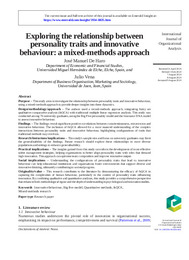Please use this identifier to cite or link to this item:
https://hdl.handle.net/11000/35301Full metadata record
| DC Field | Value | Language |
|---|---|---|
| dc.contributor.author | DE HARO, JOSE MANUEL | - |
| dc.contributor.author | Vena Oya, Julio | - |
| dc.contributor.other | Departamentos de la UMH::Estudios Económicos y Financieros | es_ES |
| dc.date.accessioned | 2025-01-26T10:21:26Z | - |
| dc.date.available | 2025-01-26T10:21:26Z | - |
| dc.date.created | 2024-08 | - |
| dc.identifier.citation | International Journal of Organizational Analysis | es_ES |
| dc.identifier.issn | 1934-8835 | - |
| dc.identifier.uri | https://hdl.handle.net/11000/35301 | - |
| dc.description.abstract | Purpose – This study aims to investigate the relationship between personality traits and innovative behaviour, using a mixed-methods approach to provide deeper insights into these dynamics. Design/methodology/approach – The authors used a mixed-methods approach, integrating fuzzy set qualitative comparative analysis (fsQCA) with traditional multiple linear regression analysis. This study was conducted among 76 university graduates, using the Big Five personality model and the Innovator DNA model to assess innovative behaviour. Findings – The findings reveal significant positive correlations between conscientiousness, extraversion and innovative behaviour. The inclusion of fsQCA allowed for a more nuanced understanding of the complex interactions between personality traits and innovative behaviour, highlighting configurations of traits that traditional methods may overlook. Research limitations/implications – This study's sample size and focus on university graduates may limit the generalisability of the findings. Future research should explore these relationships in more diverse populations and settings to enhance generalisability. Practical implications – The insights gained from this study can inform the development of more effective talent management strategies, helping organisations to better align personality traits with roles that demand high innovation. This approach can optimise teamcomposition and improve innovative output. Social implications – Understanding the configurations of personality traits that lead to innovative behaviour can help educational institutions and organisations foster environments that support diverse and innovative thinking, ultimately contributing to societal progress. Originality/value – This research contributes to the literature by demonstrating the efficacy of fsQCA in capturing the complexities of human behaviour, particularly in the context of personality traits influencing innovation. By combining qualitative and quantitative analyses, this study provides a comprehensive perspective that enhances bothmethodological rigour and the depth of understanding in psychological and innovation studies. | es_ES |
| dc.format | application/pdf | es_ES |
| dc.format.extent | 16 | es_ES |
| dc.language.iso | eng | es_ES |
| dc.publisher | Emerald Publishing Limited | es_ES |
| dc.rights | info:eu-repo/semantics/openAccess | es_ES |
| dc.rights | Attribution-NonCommercial-NoDerivatives 4.0 Internacional | * |
| dc.rights.uri | http://creativecommons.org/licenses/by-nc-nd/4.0/ | * |
| dc.subject | Innovative behaviour | es_ES |
| dc.subject | Big five model | es_ES |
| dc.subject | Quantitative methods | es_ES |
| dc.subject | fsQCA | es_ES |
| dc.subject | Mixed-methods research | es_ES |
| dc.subject.other | CDU::6 - Ciencias aplicadas::65 - Gestión y organización. Administración y dirección de empresas. Publicidad. Relaciones públicas. Medios de comunicación de masas | es_ES |
| dc.title | Exploring the relationship between personality traits and innovative behaviour: amixed-methods approach | es_ES |
| dc.type | info:eu-repo/semantics/article | es_ES |
| dc.relation.publisherversion | https://doi.org/10.1108/IJOA-04-2024-4461 | es_ES |

View/Open:
Exploring the relationship between personality traits and innovative behaviour a mixed-methods approach.pdf
Preprint
200,71 kB
Adobe PDF
Share:
.png)
